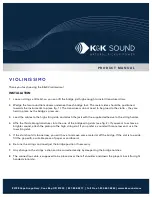
Section 14: SCPI command reference
Model 6517B Electrometer Reference Manual
14-64
6517B-901-01 Rev. C / August 2015
:AUTO <b>|ONCE *3*
This command is used to control the auto range for volts, amps, and coulombs.
Usage
[:SENSe[1]]:VOLTage[:DC]:RANGe:AUTO <b>|ONCE
[:SENSe[1]]:CURRent[:DC]:RANGe:AUTO <b>|ONCE
[:SENSe[1]]:CHARge:RANGe:AUTO <b>|ONCE
:AUTO?
<b>
1 or ON:
Enable auto range
0 or OFF:
Disable auto range
ONCE:
Enable and then disable auto range
Details
These commands are used to control autoranging. With autoranging enabled, the instrument
automatically goes to the most sensitive range to perform the measurement (
Measurement range
(on
page 5-17)).
The
ONCE
parameter is analogous to a momentary toggle switch. When
:RANGe:AUTO ONCE
is sent,
auto range enables and the most sensitive range is selected for the input signal. Auto range is then
disabled, but the selected measurement range is retained. Note that the instrument must currently be
on the specified function in order for ONCE to be effective. Using ONCE while on any other function
results in an error.
The autorange command (
:RANGe:AUTO
) is coupled to the command that manually selects the
measurement range (
:RANGe <n>
). When autorange is enabled, the parameter value for
:RANGe
<n>
changes to the automatically selected range value. Thus, when autorange is disabled, the
instrument remains at the automatically selected range. When a valid
:RANGe <n>
command is
sent, autoranging disables.
When using auto range, upper and lower range limits can be established to keep the instrument from
autoranging to ranges that are not going to be used.
Allow sufficient time for settling when autoranging over multiple ranges or down to the lower current
ranges, or erroneous readings may occur.
Also see
:ULIMit <n>
(on page 14-64)
:LLIMit <n>
(on page 14-65)
:ULIMit <n>
This command is used to set the upper limit for volts and amps.
Usage
[:SENSe[1]]:VOLTage[:DC]:RANGe:AUTO:ULIMit <n>
[:SENSe[1]]:CURRent[:DC]:RANGe:AUTO:ULIMit <n>
Also see
None
















































